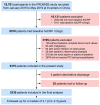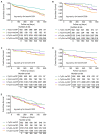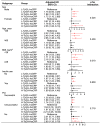Inflammation and Insulin Resistance in Diabetic Chronic Coronary Syndrome Patients
- PMID: 37375712
- PMCID: PMC10301506
- DOI: 10.3390/nu15122808
Inflammation and Insulin Resistance in Diabetic Chronic Coronary Syndrome Patients
Abstract
Limited evidence exists on the combined and mediating effects of systemic inflammation on the association between insulin resistance and cardiovascular events in patients with diabetes and chronic coronary syndrome (CCS). This secondary analysis of a multicenter prospective cohort included 4419 diabetic CCS patients. Triglyceride-glucose index (TyG) and high-sensitivity C-reactive protein (hsCRP) were applied to evaluate insulin resistance and systemic inflammation, respectively. The primary endpoint was major adverse cardiac event (MACE). Associations of TyG and hsCRP with cardiovascular events were estimated using Cox regression. A mediation analysis was performed to assess whether hsCRP mediates the relationship between TyG and cardiovascular events. Within a median 2.1-year follow-up period, 405 MACEs occurred. Patients with high levels of TyG and hsCRP experienced the highest MACE risk (hazard ratio = 1.82, 95% confidence interval: 1.24-2.70, p = 0.002) compared to individuals with low levels of both markers. HsCRP significantly mediated 14.37% of the relationship between TyG and MACE (p < 0.001). In diabetic CCS patients, insulin resistance and systemic inflammation synergically increased the risk of cardiovascular events, and systemic inflammation partially mediated the association between insulin resistance and clinical outcomes. Combining TyG and hsCRP can help identify high-risk patients. Controlling inflammation in patients with insulin resistance may bring added benefits.
Keywords: cardiac event; chronic coronary syndrome; diabetes; high-sensitivity C-reactive protein; inflammation; insulin resistance; mediation analysis; triglyceride–glucose index.
Conflict of interest statement
The authors declare no conflict of interest.
Figures




Similar articles
-
The combined effect of triglyceride-glucose index and high-sensitivity C-reactive protein on cardiovascular outcomes in patients with chronic coronary syndrome: A multicenter cohort study.J Diabetes. 2024 Aug;16(8):e13589. doi: 10.1111/1753-0407.13589. J Diabetes. 2024. PMID: 39136595 Free PMC article.
-
The effect of hsCRP on TyG index-associated cardiovascular risk in patients with acute coronary syndrome undergoing PCI.Sci Rep. 2024 Aug 5;14(1):18083. doi: 10.1038/s41598-024-69158-0. Sci Rep. 2024. PMID: 39103439 Free PMC article.
-
Joint association of TyG index and high sensitivity C-reactive protein with cardiovascular disease: a national cohort study.Cardiovasc Diabetol. 2024 May 7;23(1):156. doi: 10.1186/s12933-024-02244-9. Cardiovasc Diabetol. 2024. PMID: 38715129 Free PMC article.
-
The association between triglyceride-glucose index and major adverse cardiovascular events in patients with acute coronary syndrome - dose-response meta-analysis.Nutr Metab Cardiovasc Dis. 2021 Oct 28;31(11):3024-3030. doi: 10.1016/j.numecd.2021.08.026. Epub 2021 Aug 12. Nutr Metab Cardiovasc Dis. 2021. PMID: 34625361
-
Triglyceride-glucose index and coronary artery disease: a systematic review and meta-analysis of risk, severity, and prognosis.Cardiovasc Diabetol. 2023 Jul 6;22(1):170. doi: 10.1186/s12933-023-01906-4. Cardiovasc Diabetol. 2023. PMID: 37415168 Free PMC article.
Cited by
-
The roles of lipids and inflammation in the association between the triglyceride-glucose index and arterial stiffness: evidence from two large population-based surveys.Lipids Health Dis. 2024 Jun 22;23(1):190. doi: 10.1186/s12944-024-02183-0. Lipids Health Dis. 2024. PMID: 38909224 Free PMC article.
-
C-reactive protein-triglyceride glucose index predicts stroke incidence in a hypertensive population: a national cohort study.Diabetol Metab Syndr. 2024 Nov 21;16(1):277. doi: 10.1186/s13098-024-01529-z. Diabetol Metab Syndr. 2024. PMID: 39574139 Free PMC article.
-
The triglyceride-glucose index is a predictor of major adverse cardiovascular events in patients with coronary artery disease and psoriasis: a retrospective cohort study.Diabetol Metab Syndr. 2024 Jul 31;16(1):184. doi: 10.1186/s13098-024-01423-8. Diabetol Metab Syndr. 2024. PMID: 39085887 Free PMC article.
-
Pulmonary Hypertension and Hyperglycemia-Not a Sweet Combination.Diagnostics (Basel). 2024 May 28;14(11):1119. doi: 10.3390/diagnostics14111119. Diagnostics (Basel). 2024. PMID: 38893645 Free PMC article. Review.
-
Triglyceride-glucose index and hsCRP-to-albumin ratio as predictors of major adverse cardiovascular events in STEMI patients with hypertension.Sci Rep. 2024 Nov 15;14(1):28112. doi: 10.1038/s41598-024-79673-9. Sci Rep. 2024. PMID: 39548181 Free PMC article.
References
-
- Cavender M.A., Steg P.G., Smith S.C., Jr., Eagle K., Ohman E.M., Goto S., Kuder J., Im K., Wilson P.W., Bhatt D.L., et al. Impact of Diabetes Mellitus on Hospitalization for Heart Failure, Cardiovascular Events, and Death: Outcomes at 4 Years from the Reduction of Atherothrombosis for Continued Health (REACH) Registry. Circulation. 2015;132:923–931. doi: 10.1161/CIRCULATIONAHA.114.014796. - DOI - PubMed
-
- Li Y., Teng D., Shi X., Qin G., Qin Y., Quan H., Shi B., Sun H., Ba J., Chen B., et al. Prevalence of diabetes recorded in mainland China using 2018 diagnostic criteria from the American Diabetes Association: National cross sectional study. BMJ. 2020;369:m997. doi: 10.1136/bmj.m997. - DOI - PMC - PubMed
-
- Arnold S.V., Bhatt D.L., Barsness G.W., Beatty A.L., Deedwania P.C., Inzucchi S.E., Kosiborod M., Leiter L.A., Lipska K.J., Newman J.D., et al. Clinical Management of Stable Coronary Artery Disease in Patients with Type 2 Diabetes Mellitus: A Scientific Statement from the American Heart Association. Circulation. 2020;141:e779–e806. doi: 10.1161/CIR.0000000000000766. - DOI - PubMed
Publication types
MeSH terms
Substances
Grants and funding
- 2016YFC1301300/China National Key R&D Program during the 13th Five-year Plan Period
- 2016YFC1301301/China National Key R&D Program during the 13th Five-year Plan Period
- 2020-I2 M-C&T-B-049/CAMS Innovation Fund for Medical Sciences
- NCRC2020013/National Clinical Research Center for Cardiovascular Diseases, Fuwai Hospital, Chinese Academy of Medical Sciences
LinkOut - more resources
Full Text Sources
Medical
Research Materials

